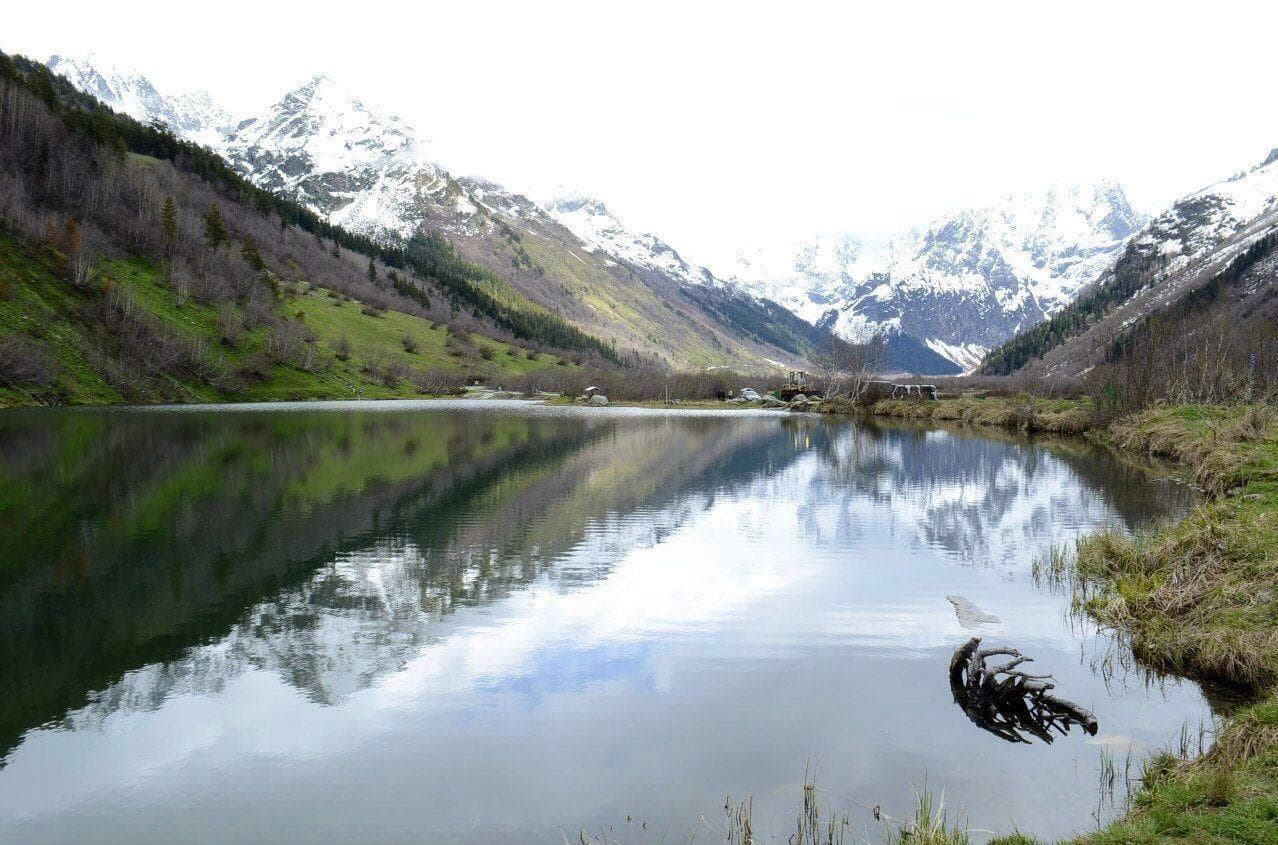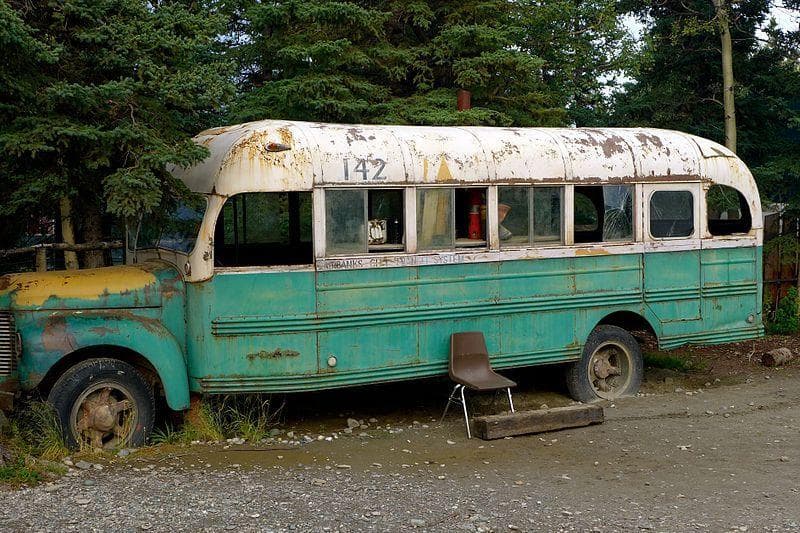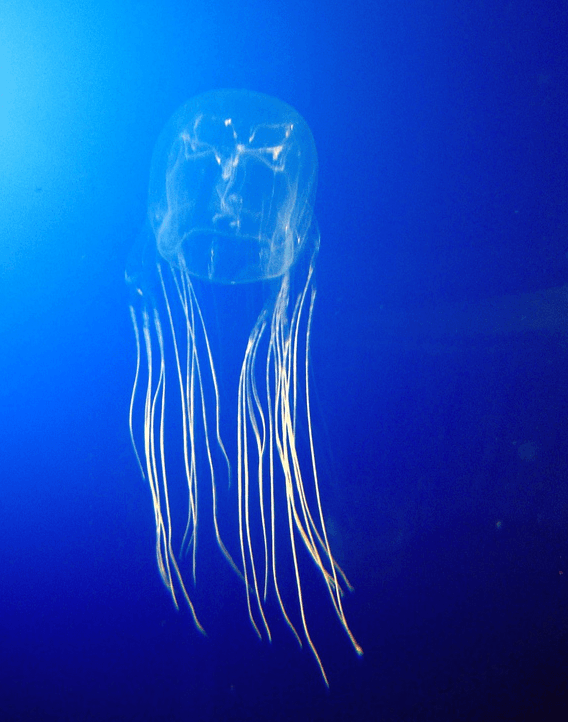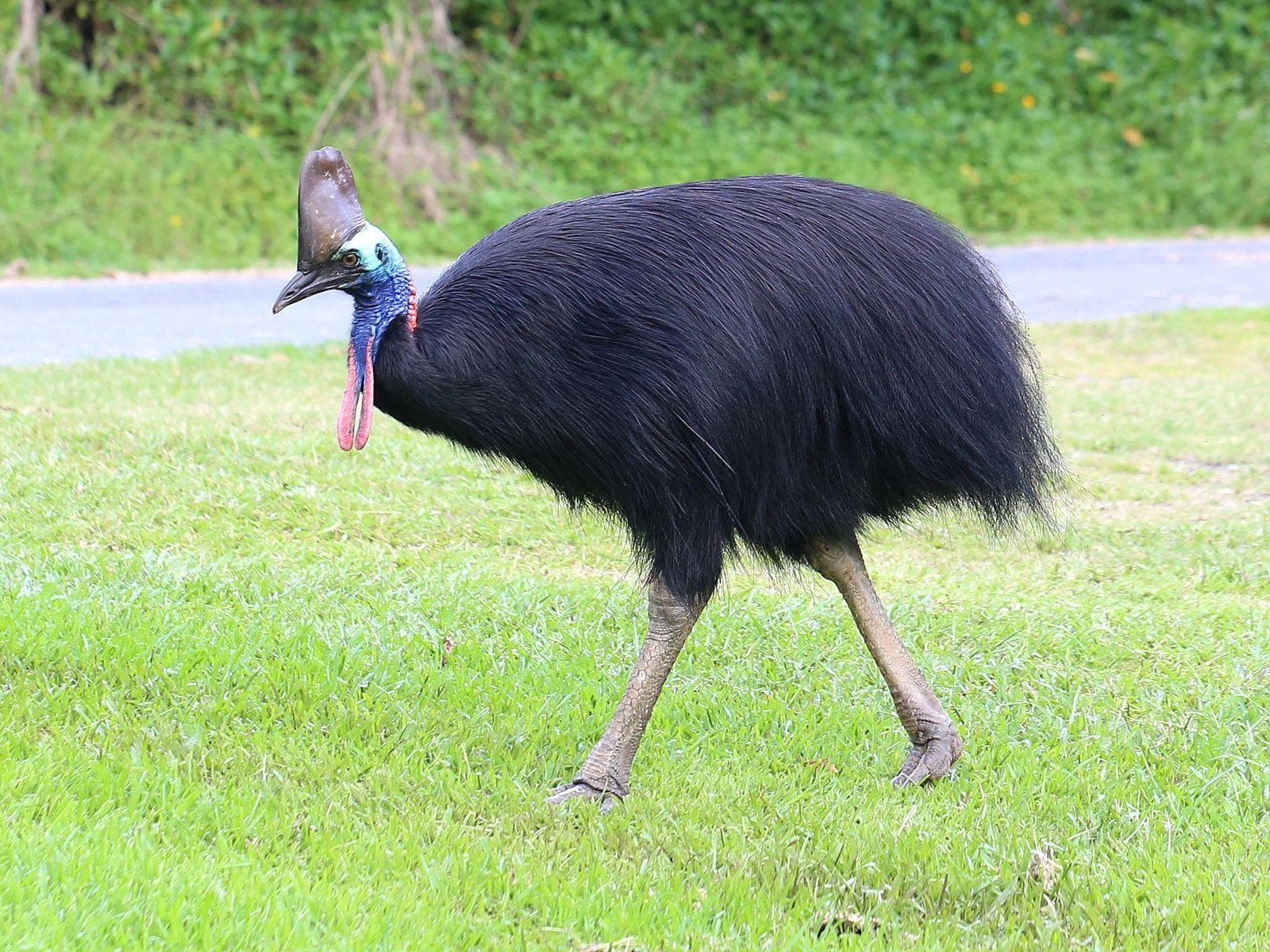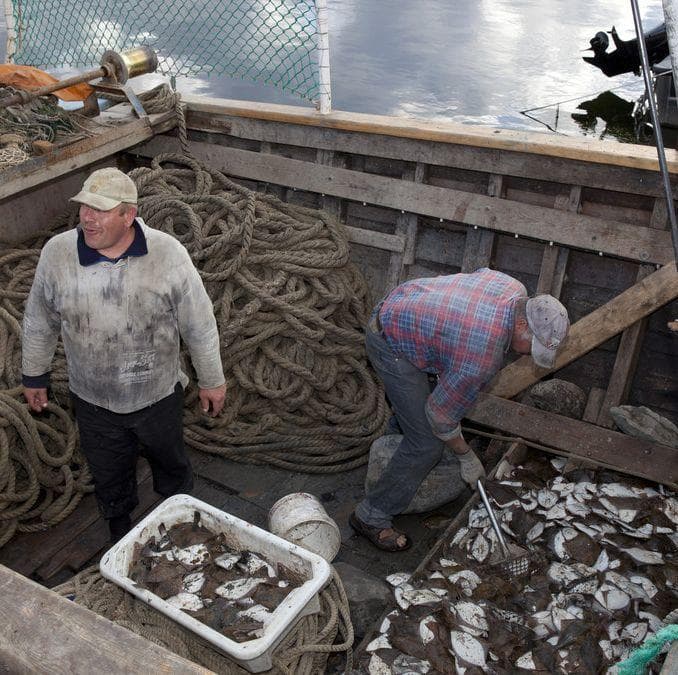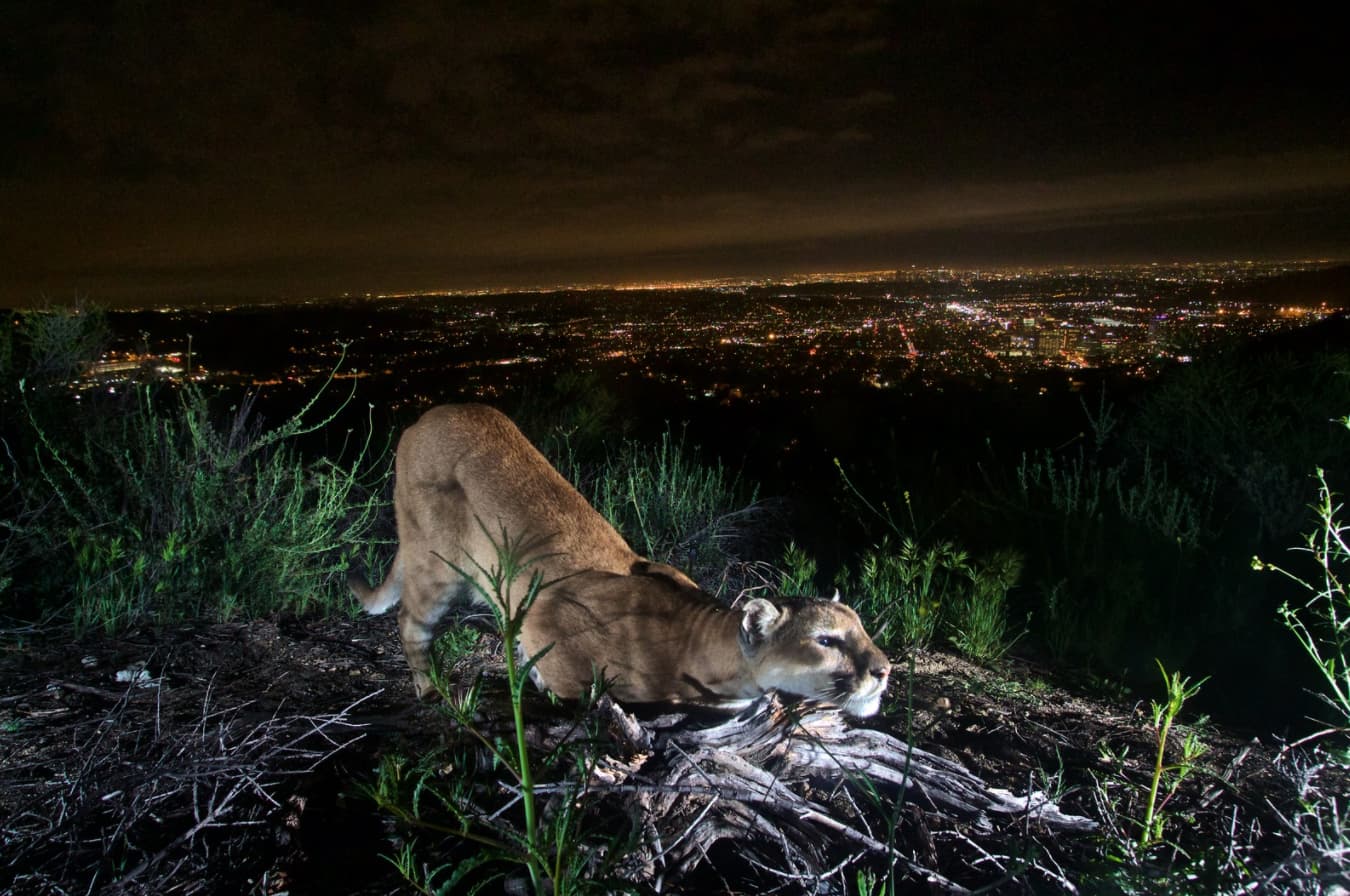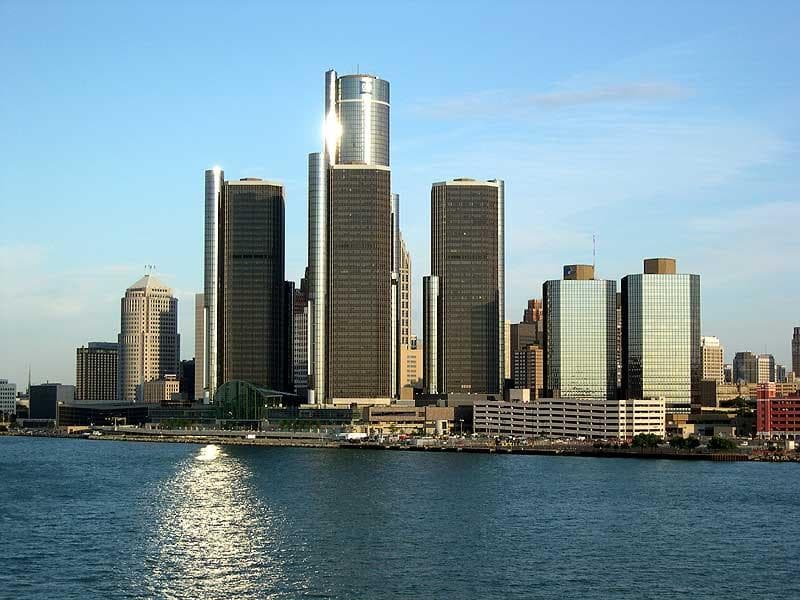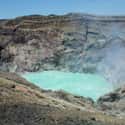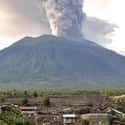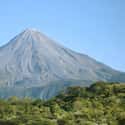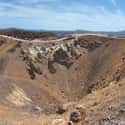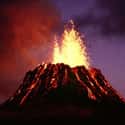-
(#1) Mayon Volcano
- Volcano
Albay, Philippines
Located in the Philippines, Mayon is the most volatile of the nation's 22 currently active volcanoes. It is a stratovolcano that sits, like so many, on the collection of subduction zones and plate boundaries known as "The Ring of Fire". It is a very active mountain -- constantly letting everyone know how temperamental it is. This is actually a benefit, as volcanoes that sit quiet and silent are the one you usually have to worry about. In the case of Mayon, the fact that it lets lots of energy out doesn't fully mitigate its danger. In fact, it caused the evacuation of the region in early 2018 when, after weeks of increasing unrest, it erupted lava 700m into the air and turned the sky black with ash.
There are 49 eruptions of Mayon in the historical record, with the (so far) most devastating one being the 1814 tragedy (VEI 4) that claimed an estimated 1,200 lives. The eruption destroyed most villages of the Albay and Camarines province. Mayon's perfectly symmetrical cone sits in the middle province of Albay with a population of over 1.2 million people. The current monitoring and response of the volcano is, so far, adequate to protect the lives of the province... the concern comes from comparing Mayon to similiar volcanos such as Pinatubo or St. Helens. If, instead of a summit eruption, a period of inflation leads to a sudden, explosive eruption at one of the fissures on the volcano’s flanks or beyond then the resulting pyroclastic flows could easily travel well past 20km. The current, evacuated danger zone around Mayon is 7km. The potential for catastrophic loss of life is huge.
-
(#2) Mount Merapi
- Volcano
Decade Volcano
Java, Indonesia
Located on the island of Java, Merapi is the most active of the 129 active volcanoes in Indonesia. It is considered one of the most dangerous volcanoes in the world due to several factors. One is that it sits inside one the most dense populations on the globe. Yogyakarta City has a population of 3 million people and sits only 15 miles away. Another 70,000 people live in the immediate vicinity. Merapi is well known for its pyroclastic flows... flows that can reach speeds of 70mph and can travel as far as 8 miles. These flows can also be re-mobilized as lahars.
This stratovolcano has had numerous moderate to large eruptions that appear to have started over 400,000 years ago. These eruptions typically begin with pyroclastic flows and are followed by widespread pyroclastic air fall. Typically, smaller eruptions happen every 2-3 years with larger ones having 10-15 years between them. The most notable eruptions on record occured in 1006, 1786, 1822, 1872 and 1930. It has been postulated that the 1006 eruption covered all of central Java with ash and that the devastation possibly led to the collapse of the Hindu Kingdom of Mataram.
Merapi's type of eruptions are more dangerous than Hawaiian-style, shield volcano eruptions because the magma in stratovolcanoes is charged with gas. As a result, when such magma finds a conduit to the surface, it can build up a sticky, hot, gas-rich plug known as a volcanic dome. The dome can build up higher and higher, and then suddenly collapse under its own weight in an eruption. This creates a very dangerous mixture of hot gas, ash and dome fragments that can flow downhill as much as 5-10 miles. This flow could wipe out anything on ridge tops because of the gas expansion, and could melt glaciers and mix with the meltwater to form very dangerous, hot and mobile lahars.
-
(#3) Mount Vesuvius
- Volcano
Decade Volcano
Naples, Italy
One of the world's most heavily monitored volcanoes, Vesuvius easily perches high in the ranks of world's most dangerous. This is not just because of its status as a very active and alive stratovolcano, but because it sits in the middle of a city of 3.1 million people. Like many stratovolcanos, this one was formed as a result of plate collision... in this case the African and Eurasian plates. One of several volcanoes that form the Camanian volcanic arc, it squats at the southern end of the chain and is the only one of its companions ( including Epomeo and Campi Flegrei ) that has erupted in the last few hundred years as well as being the only active volcano in Europe.
Vesuvius is also one of the most famous volcanoes in history, having been responsible for the nearly instantaneous destruction of Pompeii in 70 AD. The last time it erupted was 1944, causing some minor damage and killing 26 people. The research being done is showing, however, that the next time it erupts it won't be so gentle and that it is overdue for a large event. It has had 42 eruptions of VEI 3 and up and it is capable of much larger as it erupted at a VEI5 in 1631. It sits on top of a layer of magma that measures 154 square miles and thus, scientists think that the next eruption will be an incredibly forceful plinean explosion, marked by flying rock and ash at speeds of up to almost 100 miles per hour. The summit looms a mere 7.5 miles from downtown Naples and any pyroclastic flow from a volcano like Vesuvius would take only about two and a half minutes to travel that distance.
Were Vesuvius simply to repeat the same size eruption that destroyed Pompeii, there could potentially be 6 million people who would lose power, water and transportation - not to mention how many dead in the pyroclastic flows. Vesuvius is intensely monitored because of the high danger, and there would hopefully be many indicators pre-eruption... but as we know from both experience and record, volcanoes are unpredictable.
-
(#4) Mount Rainier
- Mountain
Decade Volcano
Washington, US
Considered one of the most dangerous volcanoes in the US, Mt. Rainier is also the highest peak in the Cascade mountain range. With an active hydrothermal system and thick glacial layer, it has been the source of countless eruptions and volcanic mudflows (lahars) that have surged down valleys on its flanks and buried vast areas of land... land that is now densely populated. The last magmatic eruption was around 1,000 years ago, but small summit explosions were witnessed in 1894. The real danger of Rainier, however, is its lahar potential. This mountain has 26 glaciers containing more than five times as much snow and ice as all the other Cascade volcanoes combined. If even a small part of this ice were melted by volcanic activity, it would trigger truly enormous lahars, lahars that would be incredibly destructive simply by the fact of the mountains great height and steepness.Mount Rainier has erupted less often and less explosively in recent millennia than its well-known neighbor, Mount St. Helens. However, because of the nearby population centers and the danger posed by catastrophic lahars, its threat level is much higher.
-
(#5) Mount Aso
- Volcano
Japan
Located on Kyushu island, Mt. Aso has been active for decades. At approximately 2.2 million years, it is an old volcano that got its start with basaltic eruptions and then formed its major caldera about 300,000 years ago with four huge eruptions, the last being the largest. Since the caldera formed more than 17 new cones have formed inside it. The five main cones are Neko, Taka, Naka-Dake, Eboshi, and Mt. Kishima. Only Naka-Dake is currently active: it has erupted 167 times from seven different craters since 553 CE. Two flank volcanoes, Akai and Omine sit along a fault (Oita-Kumamoto Tectonic Line) extending from the volcano towards Kumamoto City.
The dangers of Mt Aso are many, which put it high on this list. The first is that Kyushu island is densely populated. With what we know about the type of volcano that Aso is and what kinds of eruptions it is capable of, a large explosion could blast outwards in excess of 50km from the vent, leaving little chance of anything in proximity to the volcano surviving. The second is that Aso's magma reservoir is thought to be "charged" according to researchers. Hopefully Mt. Aso would give its human neighbors some warning as well as time to evacuate, otherwise it could be potentially catastrophic.
-
(#6) Mount Nyiragongo
- Volcano
Decade Volcano
Democratic Republic of Congo
Nyiragongo is not as well studied, nor monitored as a stratovolcano with its associated hazards should be. Twice in recent history it has had two devastating volcanic eruptions; the first related to its lava lake, and the second from a deadly eruption off its flank. The lava lake itself is somewhat unusual due to the viscosity and high alkalinity of its composition. This allows it to move much more quickly than, say, the lava from a Hawaiian shield volcano... upwards of 60mph. Back in 1977, the crater wall holding the lava lake ruptured and within 30 minutes the entire lake had drained, sending lava flowing to the north, west, and south of Nyiragongo. These lava flows reached up to 62 mph, wiping out several of the surrounding villages and burning almost 300 people alive.
Because of the proximity of Goma, a city of over a million people, the volcano poses a real danger. An eruption in Goma itself from fissures located within a mile of the lake shore that could lead to major explosion, and a lava eruption in nearby Lake Kivu could disturb the carbon dioxide and methane stored in the lake at depth which would lead to the release of an asphyxiating gas cloud that could disperse over a wide area. Either one of these events could lead to catastrophic loss of life.
Unfortunately, the political and humanitarian situation makes it unlikely that the population will heed warnings of an impending eruption and be prepared to evacuate part or whole of Goma as a precautionary measure. Secondarily, the population relies almost entirely on Lake Kivu for drinking water. This reliance is unchanged today and the prevention of enteric disease outbreaks like cholera after a future eruption is a major consideration. These things make Nyiragongo very dangerous indeed.
-
(#7) Iwo Jima
- Island
Japan
Iwo Jima is the island remains of a 9km-wide submarine caldera located in the central Volcano Islands of the Izu-Marianas arc. Mt. Suribachi, also called Suribati-yama, is the name of the distinctive cone on the southwest side of the island. Iwo-jima has had at least ten historic eruptions, all in this century, the most recent of which was in 1982. All of the eruptions were non-explosive or small and most were phreatic, caused by the interaction of water and magma. However, the island has undergone dramatic uplift for at least the past 700 years caused by resurgent doming of the caldera. Recently, parts of the caldera have been experiencing remarkably strong uplift of more than 1 meter per year and there is strong hydrothermal activity at present.
It is thought that it is only a matter of time before the caldera erupts, and while few people live on Iwo Jima itself, a large eruption could cause a tsunami that could devastate southern Japan and coastal China including Shanghai and Hong Kong. It has been estimated that the tsunami generated by the eruption could reach 30 meters high. This would cause massive loss of life and property.
-
(#8) Mount Tambora
- Volcano
Sumbawa, Indonesia
Responsible for one of the biggest volcanic blasts in recorded history, Tambora is located on the island of Sumbawa in Indonesia. Back in 1815, after lying dormant for 1,000 years, Tambora rumbled to life first with some heavy activity. The plinian explosion that happened next obliterated the caldera and killed more than 71,000 people on the spot. The plume then went on to cause a volcanic winter responsible for a worldwide famine. Since then Tambora remains active. Minor lava domes have extruded on the caldera floor and a small, non-explosive eruption occurred in 1967 and then again in 2011.
As of 2010, the population has reached 238 million people and climbing, of which 57.5% are concentrated on the island of Java. An event as significant as the 1815 eruption would impact about eight million people. There is constant monitoring of the volcano, however, and the local directorate has created a disaster mitigation map which sets two hazard zones in the areas surrounding Tambora. Scientists say that the mountain has a 30% chance of erupting again in this century.
-
(#9) Changbaishan
China
This volcano has some complexity to it in both name and myth. Called many things by the different regions that surround it, Changbaishan is also called Paektusan by North Korea, Baekdusan in South Korea and it has several more variations in Mongolian that basically mean Lofty White Mountain. Heaven Lake sits in the caldera at the top of the mountain. The caldera was formed by a massive VEI 7 eruption, the "Millennium" or "Tianchi" eruption of 946. This event was one of the largest and most violent eruptions in the last 5,000 years.
Now, new studies are indicating that a new eruption could eject far more sulphur into the atmosphere than previously thought, which could devastate life on Earth. The fear that has built around Changbaishan has sparked a rare collaboration with North Korea and the West, with the largely secretive nation inviting scientists from the UK and US to help study it.
If this volcano is capable of another VEI 7 eruption, it deserves its place in the top 10 of the most dangerous. It threatens the entire globe, not just the region it sits in.
-
(#10) Sakurajima
Decade Volcano
Japan
Added to the Decade list in 1991 because of its proximity to large populations, Sakurajima has basically been erupting steadily since 1955. Thousands of small explosions occur every year, though there have been no active lava flows since 1946.
Kagoshima, a city of over 600,000 people and only a few kilometers away, is highly attuned to this stratovolcano and monitors it very closely. The city runs regular evacuation drills and shelters have been built in preparation for falling volcanic debris. Because of the constant release of pressure, scientists do not feel there is a danger of immediate catastrophic eruption, however the magma dome beneath the subterranean Aida Caldera has been growing. It has been suggested that it could potentially blow within the next 25 years. As with all volcanoes, however, they are unpredictable and don't run like clockwork. The models used to forecast this coming eruption could be missing many complexities. Still, because of the nearby large population center, this volcano comes in high on the list.
-
(#11) Apoyeque
- Mountain
Nicaragua
Part of the Chiltepe pyroclastic shield volcano, Apoyeque is one of three large shield volcanoes on the Nicaraguan Volcanic Front. A smallish, unimposing volcano with a lake in its caldera, Apoyeque is nevertheless a very serious threat to the nearby capital city of Nicaragua: Managua. It has an eruption cycle of approximately 2,000 years, and the last severe eruption was 2,000 years ago. It has had smaller eruptions recently, showing its active state, with the most recent one in 2017 that spewed ash 13,000 feet above the crater.
Were this volcano to explosively erupt, the ensuing lake tsunami it would generate could bring catastrophe to the 2 million people living in and around Managua.
-
(#12) Anak Krakatau
Indonesia
You might know the name "Krakatoa" from volcanic lore. Its most notable eruption ended in a series of massive explosions that counted among the most violent eruption events in recorded history. In 1883, with an explosion measuring VEI 6, Krakatoa ejected around 6 cubic miles of rock into the air in an eruption that was heard as far as 3,000 miles away and destroyed two-thirds of the island. Based on records of the time, 165 towns were destroyed and another 132 were seriously damaged. At least 36,417 people perished, mostly from the tsunamis that came after.
Since 1927, subsequent eruptions have built a new island in the same spot named Anak Krakatau, a mostly submerged caldera with three outer islands and the new cone. And eruptions have continued on since then. Anak Krakatau has grown at an average of 5 inches a week since the 50s and has had periods of Strombolian eruptions nearly continuously. There is a growing lava dome at the center of the cone and two active vents ejecting incandescent gas. It is unknown when or how violent the next large event could be, but the island is located between Indonesia's two most populous islands (Java and Sumatra), which puts this volcano at the top of the danger list.
-
(#13) Nevado del Ruiz
- Volcano
Columbia
Located 80 miles west of Bogota, Nevado del Ruiz is a massive two million year old stratovolcano that has had three major eruptive periods in its history. The current cone formed approximately 150,000 years ago and is capable of large plinian eruptions - the type of eruption that generates extremely dangerous fast-moving pyroclastic flows. The real danger from Nevado, however, is from the glacier that caps it. This glacier, if melted by the eruption, could cause devastating lahars (water mixed with the ash and debris). In fact, back in 1985, just a small eruption produced a lahar so catastrophic that it obliterated the town of Armero in Tolima, causing an estimated 25,000 deaths. This was the deadliest lahar in recorded history. Nevado del Ruiz has generated killer mud flows before, notably in 1595 and again in 1845. Hundreds died in settlements located at the site of Armero, the same site of the catastrophe of 1985. People had forgotten about the dangers Nevado del Ruiz posed and had rebuilt the town in the same place, unwittingly setting the scene for the mass casualties to come.
Scientists actually had been monitoring Nevado del Ruiz back in 85... lahar pathways were ID'd and communities were warned. However, the eruption took place at night and the people of Amero did not get their warning in time. Their deaths, however, inspired better monitoring and disaster planning for volcano-adjacent communities around the world. Currently, over 500,000 Colombians live within 30 kilometers of the volcano, well within the range of a lahar—significantly closer than Armero. -
(#14) Santa Maria
Decade Volcano
Guatemala
Located in the Guatemalan volcanic highlands, the Santa Maria stratovolcano is home to Santiaguito - one of the most active lava dome complexes in the world. Santa Maria itself was the location of one of the largest eruptions of the 20th century in 1902: a VEI 6! This eruption blasted out one side of what had been a symmetrical cone, leaving a large crater on the south-western side of the volcano, and depositing tephra hundreds of miles away as well as generating pyroclastic flows that killed somewhere between hundreds and thousands of people. Since 1902 Santa Maria has been very active and because of this and the scale of past destruction, it is considered quite unpredictable and dangerous.
While the actual cone of Santa María itself is no longer active, the domes of Santiaguito have been growing since 1922. The bulk of these domes were built by the extrusion of lava flows, but it is so viscous that it poses no immediate hazard on eruption. Collapses of the spines, however, or larger portions of the domes themselves could potentially create dangerous pyroclastic flows to threaten the many agricultural communities and population centers that now live nearby. Because this area of Guatemala experiences an intense rainy season, it is prone to washing ash and debris quickly downhill -- the original town of El Palmar was destroyed by lahars and the new town in its place faces the same dangers.
Besides lahars, a hazard which could be devastating is the collapse of Santa María itself. The 1902 crater has left the southern flank of the mountain above Santiaguito highly over-steepened, and a large earthquake or eruption from Santiaguito could trigger a huge landslide, which might cover up to 39 square miles. However, it should be noted that this is thought to be unlikely in the short term.
-
(#15) Kelud
- Volcano
Indonesia
Since the 15th century, Kelud (or Kelut), a moderately inconspicuous-looking stratovolcano with an active and explosive history, has claimed more than 15,000 lives. The reasons for this are not necessarily that it's the most violent, but instead because it has a large crater lake at its summit that insures that any eruption will trigger catastrophic and deadly lahars. Of all the types of volcanoes on earth, it is known to be one of the most deadly.
The 1586 eruption is believed to have caused more than 10,000 fatalities and, after more than 5,000 people were killed during the 1919 eruption, an ambitious engineering project sought to drain the crater lake which has helped lower the level of the lake. The city of Malang, populated by 824,000 people, sits 30 miles from the volcano and as such, Kelud is more than capable of killing upwards of a million people were it to produce a more violent eruption.
Due to its history and nature, it is likely to also be able to produce large pyroclastic base surges and caldera forming events. In 2014, it blew the dome that had been forming since 2007 and the resulting eruption forced an evacuation of 100,000 people and killed 7. The volcano has since been moved down to the lowest threat level, but the system is once again gaining strength. Kelud has shown itself already capable of producing a large VEI-5 to a small VEI-6. An eruption of this magnitude, were it to have a short warning period, would kill everyone within a 6 mile radius.
Since it erupted with some force in 2014 this volcano has been moved down in rank considerably in terms of immediate danger, but its deadly and unpredictable history keeps it on this list.
-
(#16) Tungurahua
- Volcano
Equador
Known as "The Black Giant" or "Throat of Fire", Tungurahua is one of Equador's most active volcanoes. It has a long history of building up edifices and then collapsing them in eruption. The geologic record shows that it is capable of a VEI 5 though it generally erupts at VEI 2-4. Like most stratovolcanoes, its eruptions are characterized by large ash explosions, lava and pyroclastic flows. It has had at least 17 eruptions in recorded history and the last major one was from 1916 to 1918. During the past 1,300 years eruptive episodes were generally once per century and traditionally began with lapilli emission and pyroclastic flows, followed by lava flows or a lava plug in the crater.
Because of the communities living on its slopes and the city of Basos nearby, the volcano poses a serious threat to the populace were it to seriously erupt again. It is surrounded by several towns, with around 30,000 people living close by. Its active history, capability of strong explosive eruptions and the fact that communicating a warning to the small, low-tech villages nearby makes this mountain worrisome. Currently it shows signs of low to moderate activity and in late 2016 there was a cluster of earthquakes, up to three volcanic/tectonic events a day and fumarolic emissions rose from the rim. -
(#17) Mount Agung
- Volcano
Bali
Found in eastern Bali, Gunung Agung is a young, active stratovolcano and the highest point on the island. Only a few of its eruptions have been recorded in historical time. The 1963-64 eruption, one of the largest in the 20th century, produced voluminous ashfall and devastating pyroclastic flows and lahars that caused extensive damage and many fatalities on Bali. Although infrequent, eruptions of Mt Agung have been among the largest of the past 100 years of global volcanic activity. More than 1,000 people died during the last eruption in 1963.
In 2017 the volcano began to show serious signs of eruption and 35,000 people were evacuated as a precaution. While it did not erupt, the mountain remains closely monitored, and, based on its past eruptive record as well as the potential than any stratovolcano on a subduction zone has, scientists fear that a large eruption is coming. There remains a 6km danger zone radius around Agung and quakes still rattle the area.
-
(#18) Campi Flegrei
Italy
Located on the doorstep of Naples (in fact, the western suburbs are inside the caldera itself), Campi Flegrei is the closest thing to a supervolcano on this list. 40,000 years ago it produced a massive VEI 7 event called the Campanian Ignimbrite Eruption that collapsed an 8 mile wide caldera and blasted out 72 cubic miles of ejecta. It last erupted in 1538 after almost 100 years of building, though this event was small in comparison. In recent years, Campi Flegrei has been uplifting -- and notably, similar uplift was recorded before the 1583 eruption. Lying mostly underwater, the caldera consists of 24 craters and edifices.
Despite the continuing uplift and signs of unrest, the volcano is unlikely to erupt as a surprise event. It is intensely monitored and scientists say that we do not need to really start worrying. Based on previous eruptions, a new event would probably be preceded by uplift of meters to tens of meters due to magma refill at depths of 3 km or even less. However, the fact that there is a major city practically sitting on top of the volcano makes it very dangerous. It doesn't need a VEI 7 to cause enormous destruction and loss of life, even a small event would wreak havoc. The fact that its active and slowly uplifting... the fact that it doesn't have a traditional stratovolcanic cone to spit ejecta and steam in warning... makes this a volcano that should be watched like a hawk.
-
(#19) Mount Shasta
- Mountain
California, US
Ranked as the 4th most dangerous volcano in America by the USGS and a 'very high threat', Mt. Shasta is a stratovolcano with an active history in both the geologic record as well as the last 10,000 years. There has not been an eruption from this northern California volcano since Europeans settled here, but one was possibly witnessed in 1786 from the Pacific ocean.
The ancestral Shasta began approximately 593,000 years ago when lavas erupted in what is now Shasta's western side, and over time it built up to a large-but-unknown height. Around 3-360,000 years ago it looks like the entire north side of the mountain collapsed which created a massive landslide. Several cones were built over time up to the present tallest one named Hotlum Cone which was formed about 8k years ago. In those 8,000 years Hotlum has erupted 8-9 times.
Flanked by an interstate, Shasta looms over thousands of homes, and lava flows and pyroclastic flows could affect low areas 9 to 13 miles from the summit. Lahars could reach further down valley floors. There are also possibilities of explosive lateral blasts like St. Helens. It has been posited that, because it is old and active and has erupted only smaller amounts of lava over the past thousand years, Mount Shasta is the most likely Cascade Range volcano to produce a very large explosive eruption.
-
(#20) Mount Galeras
Decade Volcano
Columbia
One of Columbia's most active volcanoes, this stratovolcano is just to the west of the city of Pasto - a city with a population of more than 400,000 people. It has been erupting for the past 4,500 years, but has been active for over a million. During the past 100,000 years, two major caldera collapsing eruptions took place. Several other collapse events produced avalanches which blasted west and left a large horseshoe caldera behind in which the modern cone of today is found. The types of eruptive events are generally characterized by pyroclastic flows, sulfur dioxide degassing and ash plumes.
The proximity of Pasto makes the volcano a threat to life, but fortunately, the most recent collapse of the caldera wall now directs many of the eruptive flows away from the town. However, if the eruption were to be over a 3 or a 4, many thousands of people would need to be evacuated.
-
(#21) Teide
Decade Volcano
Canary Islands, Spain
Designated a Decade volcano, Earth's third-tallest volcano lives on the island of Tenerife and has a history of destructive eruptions. The volcano itself began to form 170,000 years ago after the massive collapse of the former volcanic edifice, which was even bigger than the one that stands today. Like any stratovolcano, it grows each successive eruption with increasingly viscous lava settling on top of previous flows. Today we can only see its remains because, as the inside of Teide grew, it gradually filled the caldera with its materials.
In the last 20,000 years, most eruptions have taken place around the base of Teide, because it is harder for lava to spew from the great height of 12,198 feet.
As with many volcanoes on this list, the dangers of Teide come from the pyroclastic flows produced by a plinian style eruption. A 2006 study of the volcano observed that "in the past 30,000 years, eruptions have occurred at a rate of only four to six per millennium, with a predominance (70%) of very low hazard, basaltic eruptions". The authors also postulated that the volcano posed only localized threats to the one million inhabitants of Tenerife - an interesting contrast to the hand-wringing sensationalized speculation in the press that Teide was on the verge of blowing after a normal quake swarm in October 2017.However, another study in 2009 concluded that Teide will probably erupt violently in the future, and that its structure is similar to that of Vesuvius and Etna. And so, since the magnitude of the risk posed by Teide to the public remains a source of debate, this Decade volcano sits somewhat in the middle of the list.
-
(#22) Colima
Decade Volcano
Jalisco, Mexico
Also known as Volcan del Fuego (not the one in Guatemala), the Colima Volcanic Complex is actually made up of two stratovolcanoes: Nevado de Colima and the eroded El Cantaro that is now considered extinct. It is one of the most active volcanoes in Mexico/North America and it's erupted more than 40 times since 1576. The currently active cone is in a large caldera that was probably formed by a combo of landslide and eruptions. Because of its activity and proximity to over 300,000 people, researchers began constant monitoring about 20 years ago and it was designated a Decade volcano.
Presently, Colima is in an explosive phase. The areas to the south are threatened by pyroclastic flows, secondary lahars, avalanches and lavas. The ashfall would most likely spread north. Power and water supply, roads, air traffic and communications could be seriously affected by a serious, large eruption of Colima volcano.
-
(#23) Mount Unzen
- Geographical Feature
Decade Volcano
Japan
The most famous volcano in Japan, Unzen is located in the northwestern part of Kyushu Island near the city of Shimabara. It is part of Shimabara Peninsula which has experienced a great deal of volcanic activity over the past 6 million years. There has been activity in the area from 150,000 to the present in the form of dome-building at different periods. It is the peak of Fugen-dake that has been the site of largest number of eruptions in the past 20,000 years and it lies only 3.7 miles from the center of the city. It was the Mayuya lava dome complex on the east coast of Shimabara, however, that was the source of a devastating 1892 debris avalanche and mega-tsunami that killed 15,000 people.
Today, Unzen is heavily monitored not only because of the tsunami danger, but it's also dangerous to parts of Russia and China because of the plinian ash cloud an eruption could send into the sky. The latest eruption ended in 1995, but because of its eruptive history and the danger it poses to nearby population centers, Unzen is a Decade volcano.
-
(#24) Taal Volcano
- Volcano
Decade Volcano
Philippines
Sitting on the island of Luzon in the Philippines, Taal is the second most active volcano in the country. It has had several violent eruptions in the past which have killed thousands of people. It is on the Decade list because of its proximity to large populations and therefore it is closely monitored -- a significant element in keeping a volcano lower on this list. Ample time to evacuate is our only tool when it comes to large stratovolcanoes. Taal sits inside a 19 mile wide lake-filled caldera that has produced four VEI 4 eruptions in the last 200 years and a VEI 6 (yikes!!) eruption only 5,500 years ago. No wonder it is on the Decade list.
Taal appears to follow the beat of its own drum (though, really, all of them do) in that it doesn't seem to show us a predictable cycle of eruptive behavior. Its last large eruption was in 1754, an event that lasted 7 months. It showed some signs of life in 1991 with strong seismic activity and a few ground fractures and then in 2011 the alert level was raised from 1 to 2 when earthquakes again increased.
There have been 33 recorded eruptions since 1572. Taal is actually a fairly unique volcano when compared with other stratovolcanoes. Its main crater is actually very wide and low where it sits on its own island in the middle of a caldera lake. Its geographical location give it its own, unique set of dangers. A base surge (a cloud of hot gas, ash and rock that travels horizontally up to 50mph) could cross the lake's waters and reach towns on the mainland in minutes, burning or blasting away people and things. Seiches (lake water oscillation) or volcanic tsunamis could go as high as 10 feet. Ashfall, lava flow and earthquakes could also slam into the surrounding communities. To make things worse, the larger exterior walls of the old caldera are very steep and the fleeing population of over 6,000 would have to get over these barriers before they were trapped inside with the volcano
For now, Taal remains at level 1 as it has for the past decade. But because of its unpredictability and lack of a clear cycle in the geologic and historical record, it remains a highly dangerous volcano.
-
(#25) Katla volcano
- Volcano
Iceland
Located on the southern end of Iceland's eastern volcanic zone, Katla, one of the country's largest volcanoes, lurks below the Myrdalsjökull icecap. It is one of Iceland's most active volcanoes and is capable of producing destructive jökulhlaups (glacial-outburst floods). Katla has also been the source of frequent subglacial explosive eruptions that have been among the largest tephra-producers in Iceland in recorded history. The last major eruption, a VEI 5 (same explosive power as Mt. St. Helens) happened in 1918 and the resulting lahars actually extended the southern coast by over 3 miles. Before 1918 and after 930 AD, twenty eruptions have been documented at average intervals of 40-80 years, most of which experienced glacial floods. The flood waters from a 1755 eruption were estimated to be comparable to the average discharge of the Amazon, Mississippi, Nile, and Yangtze rivers combined. Most importantly, this volcano has shown itself capable of VEI 6 eruptions.
Katla, statistically due for a new eruption, is being very closely monitored and an eruption in a not too distant future would not come as a big surprise. After the 2010 Eyjafjallajökull eruptions, increased earthquake activity was recorded and since 2011 it has continued showing signs of unrest, with many hundreds of small earthquakes. When Katla finally erupts again, days of ashfall, tephra clouds, lightning and glacial flash floods are expected to impact the environment immediately. Past eruptions have even caused tidal waves, a concern for the residents of Vik as well as farming communities who live in the potential fallout zone. Given the wind direction, it is also a high possibility that Katla’s ash cloud might affect European air travel, as Eyjafjallajökull did. The volcano is being closely monitored by the Icelandic Met Office and is considered a very dangerous volcano. -
(#26) Lake Ilopango
- Crater lake
El Salvador
Located on the borders of San Salvador, La Paz, and Cuscatlán, Ilopango is now a tranquil lake-filled caldera. There is little visual sign of the massive VEI 6 eruption that devastated the region in 450 CE. This violent explosion destroyed the land in a 60 mile radius and killed thousands of Mayans and ended their presence in the highlands of the area. The ash-cloud blanketed 10,000 square km in 3 feet of pumice and ash, destroying agriculture for decades. It is also theorized that the eruption led to the abandonment of Teotihiucan by the original inhabitants and that it might have caused the extreme weather events of 535–536 in Europe. The eruption caused the collapse that formed the caldera the lake currently sits in, but the volcano remains beneath, slowly recharging.
Now, new research (2016) is showing that the volcano might be getting ready for a comeback. Scientists from the UK have found evidence that a pool of magma is building up 3.7 miles beneath Ilopango's caldera and the evidence suggests that the capital city of El Salvador might be at risk for a future volcanic eruption. Because of the known power of past eruptions, because this volcano has been sleeping for so long and because of the sheer numbers of people living practically on top of it - Ilopango is a threat to El Salavador.
-
(#27) Ulawun
- Volcano
Decade Volcano
Papua, New Guinea
One of the most active volcanoes in the world, and one of the Decade volcanoes, Ulawun is the highest volcano in the Bismarck volcanic arc on Papua, New Guinea. There is concern that, as the highest of the arc, that it may have reached the limit of its structural stability. There have been 22 major eruptions since the 1700s including a more recent event in 1980 when the volcano ejected ash 60,000 feet into the air and devastated an area of 12 square miles with pyroclastic flows.
Because the structural integrity of Ulawun is questionable, massive slope failure is a major hazard. One which could threaten hundreds of square miles of surrounding land. This, plus the normal dangers of pyroclastic flow and large explosive plinian style eruptions, could cause mass devastation.
-
(#28) Semeru
- Volcano
Indonesia
Also known as Mahameru ( The Great Mountain ), Gugung Semeru is the tallest peak on the island of Java. Like all the volcanoes in Indonesia, it is a stratovolcano that sits on the subduction zone between the Indo-Australia and Eurasia plates. It has been in a near-constant state of eruption since 1967 and, so far, all the recorded eruptions have been moderately small ( VEI 2 and 3). Currently, the clockwork activity of the volcano is located at Jonggring Seloko crater in the southeast. Typically, eruptions happen every 20-30 minutes in the form of ash emissions and projectiles ejected onto the rim. While this doesn't sound very scary, more than 500 people have been killed by Semeru over the last 30 years.
Unlike some other volcanoes on this list, Semeru's sediment yield does not decline post-eruption because of the daily supply of pyroclastic debris from the cone which is then re-mobilized during the rainy season as mudflow and lahars. The city of Lumajang, with a population of over a million people, is inside the lahar reach zone. If Semeru were to erupt more vigorously in the future, it would be catastrophic.
-
(#29) Mount Etna
- Place
Decade Volcano
Italy
Mount Etna is the largest and most active of the three active volcanoes in Italy, being about two and a half times the height of the next largest, Mount Vesuvius. It is also one of the world's most frequently erupting. From about 35,000 to 15,000 years ago, this volcano experienced highly explosive eruptions and large pyroclastic flows that appear to have reached as far as just south of Rome's border 497 miles away. The deadliest Etna event happened in 1669 when the eruption killed as many as 200,000 people.
Sitting on the active fault between the African plate and the Ionian microplate, Etna is actually a series of nested stratovolcanoes with four distinct summit craters. It is also a volcano on the move, sliding towards the Mediterranean Sea at an average rate of 14 mm per year. It is capable of multiple types of eruptions: effusive, phreatic and explosive. The eruptions the volcano displays regularly pose little threat to the million-plus people living on its slopes, instead the true danger lies in flank eruptions which could potentially cause much more damage as vents and fissures open at lower, inhabited elevations. This, plus the movement of the mountain itself could contribute to a massive landslide which could in turn cause monstrous tsunamis.
This is a very urbanized volcano, especially on its southern side, which is what puts it on the Decade list. It is very important to point out that scientists want it to be clear that there is no known danger any time soon. Hence, this volcano is lower on the list. -
(#30) South Sister
Oregon, US
Of the Three Sisters volcanic center in Oregon, South Sister (also known as 'Charity'), is the tallest of the three siblings. Unlike the other two, North and Middle, South Sister still has an un-eroded summit crater and it holds a lake in its center. It is a fairly young volcano, being no more than 50,000 years old, and its last eruptive events were 2,200 and 2,000 years ago. These moderately recent eruptions generated pyroclastic flows and lava domes from vents on the northern, southern, eastern, and southeastern sides of the volcano and they suggest the presence of a magma chamber under South Sister, one that could perhaps lead to future eruptions. The other two mountains seem to be extinct.
South Sister poses dangers to the rapidly growing communities nearby from the usual slate of stratovolcano hazards: lahars, tephra, pyroclastic flow, and lava. This is not to mention the landslide danger of the steep flanks which don't even need an eruption to send entire portions of the mountain down into the surrounding populations. The volcano was found to be potentially active in 2000 when satellite imagery showed a deforming uplift 3 miles west of the mountain. By 2013 the uplift had slowed, though the area is still considered potentially active. As of 2009, semi-permanent GPS networks have been deployed every year at the Three Sisters complex and show that uplift persists. Currently, scientists do not think that an eruption is likely, but the potential remains and if St. Helens ( a fellow Cascade volcano) has taught us anything, it is to deeply respect the power of the stratovolcanos in this range.
-
(#31) Tatun Volcano Group
- Location
Taiwan
A volcanic group located in the northernmost part of Taiwan, the Tatun group is a cluster of about 20 volcanoes that sits just 13 miles away from Taipei and the 6.5 million people who live in range. It last erupted around 650 AD, which roughly corresponds to the end of activities at the Yuanshan neolithic site.
New 2017 research has shown that the magma body under the group is a single lens or a series of sills that might mean the full magmatic system could be as large as 220 cubic miles, depending on what percentage of the system is molten. Despite this it should be noted that the magma chamber is about 20 km underground, and as long as the chamber is no closer to the ground than 10km, there’s not much need to be alarmed yet. Local officials have established a monitoring system for the Tatun Group given its proximity to Taipei and the fact it's been active more recently than previously thought. As with all volcanoes, the potential for a devastating eruption is possible... but in Tatun's case, hopefully not for a good long while yet.
-
(#32) Öræfajökull
- Volcano
Iceland
The largest volcano in Iceland is also its tallest peak. It was responsible for Iceland's largest explosive eruption in 1362 as well as a second in 1727-28 and both were accompanied by massive jökulhlaups (glacier outburst floods). Sometime during the last interglacial period the volcano experienced a VEI-6 eruption that created the caldera. The magma type Öræfajökull produces is highly prone to be explosive, being full of volatile gases and hotter than normal.
Öræfajökull sits a full 200 miles away from the capital of Reykjavik, but because it has shown the ability to produce such large and destructive eruptions and because so little is known about it, its threat looms large. Because of its explosive capabilities it could do more than just cause a headache for air travel ( ash is very damaging to airliner engines). The 1783 eruption of another Icelandic volcano (Laki) released a toxic cloud over Europe, killing tens of thousands of people and sparking famine when crops failed.
In 2017, earthquake activity increased beneath the summit crater and the threat level was raised to yellow by the Aviation Color Code of the United States when an ice-cauldron appeared in the crater along with geothermal activity under the glacier. Scientists rushed to install monitoring equipment and evacuation and emergency plans have been put in place.
-
(#33) Santorini
- Geographical Feature
Decade Volcano
Greece
Located in Greece, Santorini is a shield volcano with an ominous reputation; having been responsible for one of the few eruptions in human recorded history thought to have ended a civilization. In 1,650 BC it exploded with the force of a VEI 6, erupting 7 cubic miles of magma and creating the caldera. The plinian column of ash was thought to have reached 23 miles into the air and the eruption probably caused the end of the Minoan civilization on Crete through a giant tsunami.
Santorini has erupted many times, with varying degrees of explosivity. Since its beginnings, there have been at least twelve large eruptions at intervals of an average 20-30,000 years, of which at least four were caldera-forming. Because of that long interval, it is not thought that another VEI 6 will happen any time soon, but the volcano is capable of smaller eruptions as well that could be potentially catastrophic considering the large population currently sitting on top of the island group. Santorini, together with its neighbor Colombo Reef, share the distinction of being active Greek volcanoes alongside Kos, Methana, Milos, Nisyros and Yali
Santorini was subsidizing up until a couple of years ago when an earthquake swarm at Colombo Reef led scientists to believe that an eruption might be coming... and lately there have been more signs. Swarms of earthquakes inside the caldera at the right depth have occurred, as well as harmonic tremoring (which is the signal of a charging magma chamber) lasting from hours to days. This sort of signaling happens in shield volcanoes all the time with no resulting eruption, but it could also mean that the risk of eruption is rising. Any eruption now would likely be a dome-forming event, the beginning of which would be explosive and then turning effusive as lava extrudes. It seems likely it would be a VEI 2 or less, but something larger should not be excluded. A very large event could catastrophically affect the whole island's population of 15,550, but it is also a popular tourist destination and those numbers should also be considered. As with all the volcanoes on this list, Santorini is not likely to deliver a disastrous eruption any time soon, but because it is active, its dangerous potential must be respected.
-
(#34) Mount St. Helens
- Stratovolcano
Washington, US
The youngest and most active of the cascade volcanoes in the Pacific Northwest, St. Helens is probably the most famous US volcano outside Kiluaua. It began forming 40,000 years ago, along with the others in the range, based on the subduction of the Juan de Fuca plate under the North American. After the initial period of building activity, the volcano went through several periods of long dormancy periods followed by stretches of eruptive activity. By 1647 it had reached its greatest height and it went quiet for the next 150 years. Then, in 1800 it began another eruptive cycle that lasted 57 years before, yet again, going quiet.
In 1980, it roared violently back to life again in a VEI 5 . The eruption on May 18th began with a landslide as the growing dome of lava inside the edifice finally pushed a fraction too much against the shell of the steep, fragile mountainside. At first it was believed that the 5.1 quake that accompanied the largest debris avalanche in recorded history was what spurred it, but it was later thought that the slide itself was responsible for the 5.1 reading. The entire north flank of the mountain blasted outwards and sloughed off in spectacular fashion. A total of 3,900,000 cubic yards of ice, snow, water, ash, trees and earth was transported 17 miles south into the Columbia River.
St. Helens remains quiet now, but active. Scientists think it is unlikely we will see a repeat of 1980's blast any time soon. There has been some dome building, dome collapse, and steam and ash eruptions, but nothing that threatened the surrounding areas. However, this mountain has shown us plenty of activity in its lifetime and its never wise to get complacent. Thus, St. Helens remains on the list, but low.
-
(#35) Avachinsky
- Volcano
Decade Volcano
Russia
Found in Russia, Avachinsky is the most active volcano on the Kamchatka peninsula. Eruptions from Avachinsky, considered a Somma volcano (a volcanic caldera that has been partially filled by a new central cone), are mostly explosive and are often accompanied by avalanches and mud flows. It sits, like so many volcanoes, on a subduction zone - where the Pacific plate slides under the Eurasian plate. Its last eruption in 2008 was tiny compared to the volcano's major VEI 4 eruption in 1945 which created a steep-walled crater with a diameter of 1082 ft and a depth of about 853ft. Located just over 15 miles from Petropavlovsk-Kamchatskiy, Kamchatka's largest city, it has erupted 16 times since 1737.
Avachinsky threatens this nearby city with potential ash plumes, ash falls, lava and pyroclastic flows, hot avalanches and lahars. Due to its proximity to flight paths it is considered a threat to aviation, and future explosive eruptions could deposit up to 10 cm of ash 18 miles downwind of the volcano. The area in and around the volcano experiences frequent earthquakes and many fumaroles, emitting gases that have been measured at over 752 °F exist near the summit. Avachinsky was put on the Decade Volcano list in 1996 along with its nearby neighbor Koryaksky.
-
(#36) Mount Karthala
- Volcano
Comoros
The only active volcano in the three-island nation of Comoros between Africa and Madagascar, Karthala is moderately young at around 130,000 years old. It is classified as a Hawaiian-type shield volcano with about 2.5 miles of it submerged in the ocean. More than 20 eruptions have been recorded since the 19th century from the summit caldera and vents on the flanks; multiple lava flows reaching the sea on both sides of the island. An 1860 lava flow from the summit caldera traveled 8 miles, all the way to the capital city of Moroni. Strangely, Karthala's behavior changed after 1995. Before that year, volcanic activity occurred only about once every decade, but since then it has stepped up and now erupts almost annually.
In 2005 Karthala had a larger eruption when large lava flows and deadly gas evacuated 20,000 people. The scale of the eruption highlighted how unprepared the population was for such an event - making this volcano markedly more dangerous. That, plus the fact that it is not well-studied nor even understood jumps its danger up even higher. The eruption, only realized two hours before, dumped ash up to five meters deep on the island and contaminated scarce water supplies. A larger eruption, were it to happen, might generate ash, poisonous gases such as carbon dioxide and sulphur dioxide, mudslides, earthquakes and it is a possibility (though not probable) that part of the mountain would split off and fall into the sea, resulting in tsunamis.
-
(#37) Mauna Loa
- Volcano
Decade 16 Volcano
Hawaii, US
Located on the Big Island of Hawaii, Mauna Loa is the largest subaerial volcano on Earth in both mass and volume. It is a member of the Decade project because of its potential hazard and has been closely monitored since 1912. A shield volcano over the Hawaiian hotspot, Mauna Loa has been erupting for at least 700,000 years... perhaps only emerging above sea level 400,000 years ago. In another 500,000 to a million years, the crust will eventually drift the islands away from the hotspot, at which point the volcano (and the other Hawaiian volcanoes) will go extinct.
Mauna Loa's most recent eruption occurred in 1984 which, along with other recent events, caused no fatalities. However, eruptions in 1926 and 1950 destroyed villages, and the city of Hilo is partly built on lava flows from the late 19th century. Lava eruptions from Mauna Loa are silica-poor and very fluid, and they tend to be non-explosive, so the potentially greater hazard at Mauna Loa is a sudden, massive collapse of the volcano's flanks, like the one that struck the volcano's west flank between 100,000 and 200,000 years ago and formed the present-day Kealakekua Bay.Deep fault lines are a common feature on Hawaiian volcanoes, allowing large portions of their flanks to gradually slide downwards. Large earthquakes could trigger rapid flank collapses along these lines, creating massive landslides and possibly triggering equally large tsunamis. These tsunamis are what puts this volcano so high on the list, since the lava flows themselves - while destructive to property - can usually be avoided.
-
(#38) Kilauea
- US Census Designated Place
Hawaii, US
Kīlauea is one of the world's most active volcanoes. Unlike many of the volcanoes on this list, and like Mauna Loa, it does not sit on a plate boundary and is, in fact, a hotspot volcano. It's young in comparison to most of the others listed here as well, only between 300,000 and 600,000 years old. It emerged above sea level about 100,000 years ago as the second youngest product of the Hawaiian hotspot and the current eruptive center of the Hawaiian–Emperor seamount chain. It makes up the southeast side of the Big Island of Hawaii and stands at 4,190 feet. It was originally believed for many years to be a poart to the larger Mauna Loa to the north, but it is now known to be its own volcano with its own magma source. It has been the site of nearly continuous activity during the 19th century and has had ore than 60 recorded eruptions in its current cycle.
In 2018 it erupted dramatically after a week of increased earthquake activity which allowed scientists to warn the population of an imminent event. A 5.0 quake struck the Big Island and the East Rift zone split open into multiple vents spewing lava and gas. It is definitely a dangerous volcano, and is responsible for the cumulative loss of hundreds of homes, roads and structures... but the slow-moving nature of a shield volcano's lava allows populations to move out of its way given enough warning.
-
(#39) Dabbahu Volcano
- Volcano
Ethiopia
Located in Ethopia, Dabbahu sits on the Somali plate, in an area known as the East African Rift. Unlike many of the locales on this list, which sit on subducting plates, this plate boundary is rifting apart. It is thought that, in a million years or so, the land in this area will break away from the African continent, creating a new island.
Dabbahu itself is a stratovolcano that is part of the highly active volcanic region known as the Afar Triangle. The volcano became the center of attention when, in 2005, it opened a large fissure in the ground. Preceding this eruption, the ground swelled and shook with over 130 earthquakes that measured up to 4.2 on Richter. The fissure was no joke, reaching 37 miles long and almost 100 feet wide.
The reason this volcano sits on the list is because the eruption of 2005 was its first eruption in recorded history. This sudden and - more importantly - unexpected surge to life makes it one to watch, and a real danger to the neighboring villages.
-
(#40) Popocatépetl
- Volcano
Mexico
Located 43 miles southeast of Mexico City ( 19 million people), Popocatépetl is a very active stratovolcano in central Mexico. It is the most active volcano in the country, having had more than 15 major eruptions since the arrival of the Spanish in 1519. It was dormant for about 50 years before coming back to abrupt life in 1994. For the most part, Popo (as the locals call it), has mostly sent up regular ash plumes that coat the mountain in a thick blanket of ash. This has the potential to create deadly lahars when mixed with a lot of rainfall.
Popo is a danger to people because of its lahars, its propensity to generate earthquakes, and its proximity to a very large city... but it is last on the list simply because its past eruptive capabilities appear to be of the VEI 1-2 variety and because its activity is so regular. This is not to say that it should ever be ignored, but it can't compete with the dangers of some of the monsters further up the list.
New Random Displays Display All By Ranking
About This Tool
Volcanoes can be said to be the most spectacular and dangerous geological phenomenon on earth. Active volcanoes are even more dangerous. Some volcanic eruptions are more powerful than the explosion of 20,000 atomic bombs. For example, the Colima volcano is known as one of the most destructive volcanoes in the world, in just a few decades, it has erupted 25 times, with a column of rubble smoke as high as 5,000 meters.
The volcanic eruption is a peculiar geological phenomenon and a manifestation of crustal movement. The red lava flowed out of the ground with the eruption, enough to burn down a bustling city, and the scene was like hell. There is a collection of random 40 of the most dangerous volcanoes in the world.
Our data comes from Ranker, If you want to participate in the ranking of items displayed on this page, please click here.


